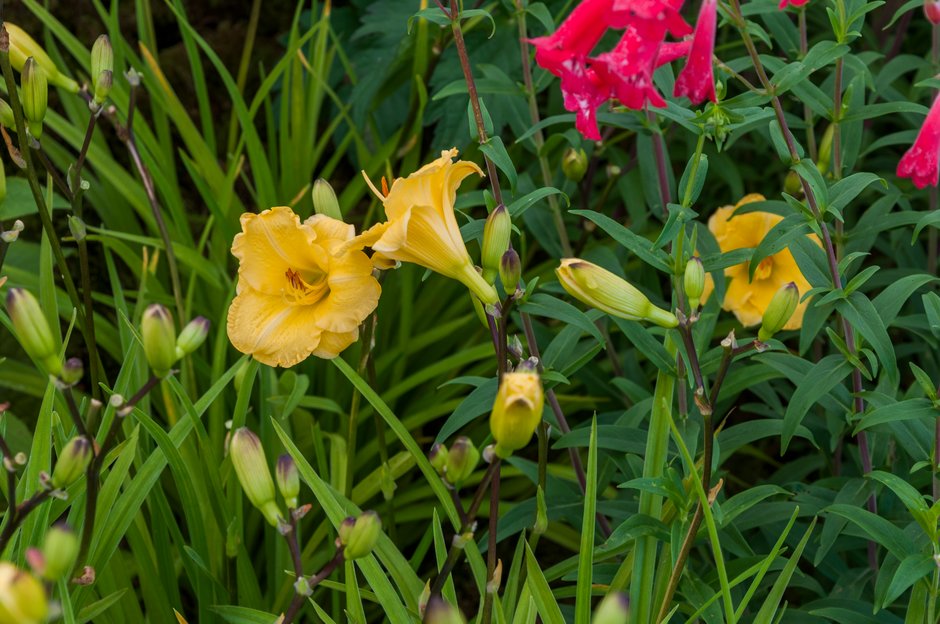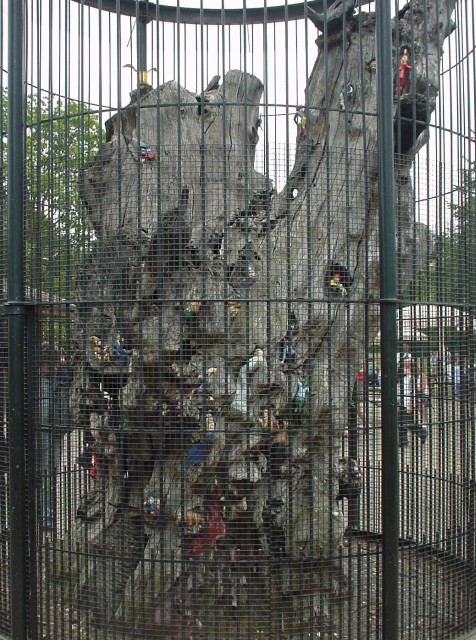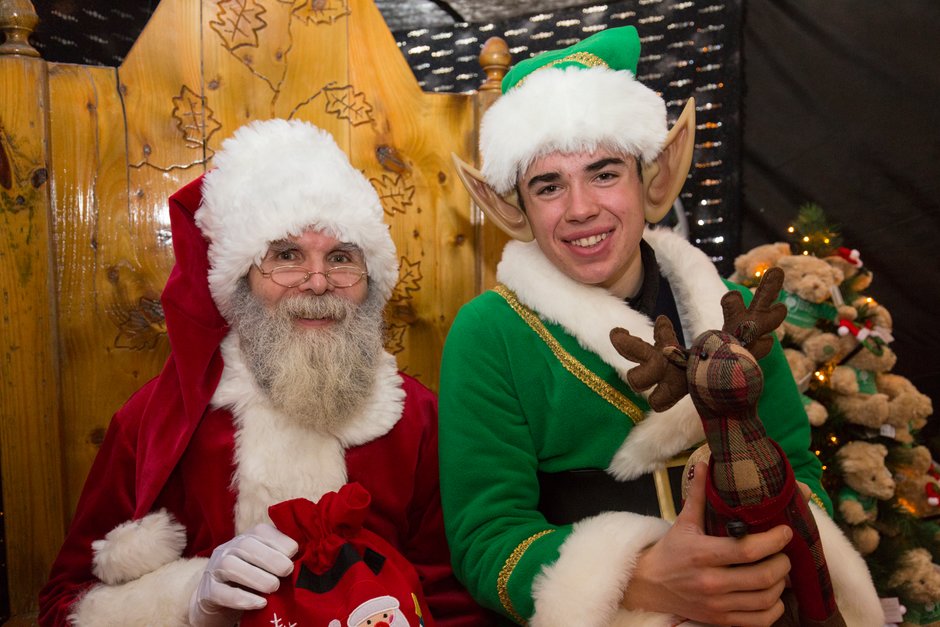By Yvette Harvey
Who would have thought that the author of Little Women could have had such a significant role in today’s advent blog about plants… For it was Louisa May Alcott who first introduced us to the elf, maker of our beloved Christmas presents and immortalized in the names of over 100 ornamental plants.In the 1850s Louisa May Alcott, the American novelist, abolitionist, feminist and jogger (yes, really) first wrote about elves in her unpublished book Christmas Elves. Her elves, based on our modern notion of small male humans robed in green onesies, pointy hats, medieval pointinini style shoes and enslaved in Father Christmas’s toy workshop may have evolved from the Scandinavian pagan belief that elves were house gnomes who guarded their places of residence from evil.
Louisa May Alcott style elves are currently on display all over the world. Here is one of the ones encountered at RHS Garden Wisley in 2016 ©RHS
But I digress, our elves are spectacularly showy, beautifully aromatic, fabulously colourful and provide delight throughout the year, so not just for Christmas. We have so many different kinds of elves that I will have to break them down into different categories for a more in depth look.
Rainbow elves
So, contrary to popular belief, elves come in a variety of different colours. The majority of elf cultivars are either pink or red, but we also see scarlet, emerald, golden, blond, blue and green ones too.
One of the most showy has to be the summer favourite, Alstromeria ‘Red Elf’. This particular plant featured in a trial at RHS Garden Wisley and is the proud holder of an Award of Garden Merit. Wonderful for the ‘hands-off’ gardener as it is best left undisturbed and will flower profusely if neglected until the autumn.
Pictured here: Alstroemeria ‘Red Elf’, Pittosporum ‘Green Elf’ and Ajuga ‘Pink Elf’ from the RHS herbarium at RHS Garden Wisley ©RHS
Planty elves
It will come as no surprise to botanists and horticulturists alike to discover that some of our elves have been named after plants and fruits.
Fruity elves
We have two of these: Iris ‘Apricot Elf’ and Pelargonium ‘Tangerine Elf’. The latter is a stellar Pelargonium, so named because the pointed petals resemble a star. This is a particularly striking plant as it has two-tone petals. The former is a standard dwarf bearded (SDB) Iris with light orange petals, and falls spotted with chocolate-pink. This sun loving plant, first registered in 1978, gained the Award of Merit in 1985.
Flowery elves
Some of our elves have been named after other flowers, in spite of being in the wrong genus, so we have:
Ficaria verna ‘Primrose Elf’. This former Ranunculus, first discovered near Torquay is a tiny little plant and has equally tiny yellow flowers.
Gladiolus ‘Rose Elf’ (a Canadian bred Glad from the Grandiflorus Group with small-flowered flesh pink and yellow two tone coloured flowers); Penstemon barbatus ‘Rose Elf’ (masses of pink flowers with darker lower lips, and another good choice for the hands-off gardener as it is a low maintenance plant); Rhododendron ‘Rose Elf’ (early pale lavender conical flowers and known to be drought resistant, so ideal if you are in an area subject to a diminishing water source) and Saxifraga ‘Elf Rose’ (a beautiful small, pink/yellow flowered plant ). Adding to our literary list, ‘Rose Elf’ is the tiny elf who featured in Hans Christian Andersen’s “rosen-alfen”.
And finally we return again to Iris, this time for ‘Aconite Elf’, a purple bloomed Miniature Dwarf Bearded Iris introduced in 1975. Aconitum is not the first genus that springs to mind for what is a tiny, early season plant.
Geographically distinct elves
Within the UK we have a plethora of regionally distinct Elves from far North to far South starting with Fuchsia ‘Eschott Elf’ (Eschott is a picturesque airfield in Northumberland), this is a single white flowered shrub, introduced in 1976. Geum ‘Eden Valley Elf’ (in Cumbria) is a small plant (to c. 30 cm) that has cherry pink flowers emerging from brownish-red stems, made all the more striking by the yellow-green leaves. Next comes Chrysanthemum (Dendranthema) ‘Pennine Elf’ (range of hills separating NW England from Yorkshire and NE England) which is an early flowering outdoor spray chrysanth. Then there is Fuchsia ‘Belvoir Elf’ (Belvoir is an area of outstanding beauty bordering Leicestershire, Nottinghamshire & Lincolnshire) is what many first think of for a Fuchsia as it has vibrant red sepals teamed with light violet corollas. And finally, Ficaria verna ‘Torquay Elf’ (holiday town made famous by Fawlty Towers), discovered in 1993, with tiny vibrant yellow flowers with bronze coloured outer surface.
And looking a little further afield, we have Hemerocallis ‘Irish Elf’ (introduced in 1978, an early-midseason yellow flowered plant to c. 40 cm tall) and Astilbe ‘Glenroy Elf’ (Glenroy is a suburb of Melbourne). The RHS’s herbarium specimen was made from a plant presented by The Lakeland Horticultural Society, holders of one of Plant Heritage collections devoted to this genus.
Habitat elves
We only have three in this category. Hosta ‘Woodland Elf’, is considered one of the finest miniatures, with its wonderfully two-tone leaf of pale yellow-green middle and cream margins. There a two Iris that are proving difficult to track down, first is a Miniature Dwarf Bearded Iris ‘Arctic Elf’ that was registered in 1975, and even more elusive is ‘Prairie Elf’ who appeared in the American Iris Society Iris Checklist 1959-1989.
Frozen elves (name associations with the well-loved Disney film)
Lathyrus vernus ‘Little Elf’ a clump forming spring bedding sweetpea with pink standards and white keels.
Kniphofia ‘Little Elf’ immortalised in Chris Whitehouse’s magnificent RHS publication: Kniphofia: The Complete Guide. This small, grass-leaved poker has pure orange flowers.
Primula auricula ‘Elf Star’, a wonderfully old fashioned auricula with a white centre ringed with velvety dark reddish-purple that changes to pale lilac fading towards the margin.
There are two Standard Dwarf Bearded Iris featured in this category: ‘Royal Elf’, registered in 1978, and ‘Snow Elf’, a white-flowered SDB. And Hemerocallis has three Frozen elves: ‘Dancing Elf’ that opens its yellow flowers in the very early morning; ‘Enchanted Elf’, the midseason plant whose flowers are graduated from a yellow throat to cream-coloured margins; and ‘Snow Elf’, with near white flowers with a green throat.
‘Snow Elf’ is proving the most popular epithet as we also have a Chrysanthemum,and an Iris ‘Snow Elf’.
Usurper elf
This is one of the Wilson 50 Kurume azaleas. Rhododendron ‘Elf’ is actually Wilson no. 12, R. ‘Kasumi-gaseki’. EH Wilson first encountered Kurume azaleas in 1914 during a visit to Hatagaya, north of Tokyo. He instantly fell in love with them and returned to Japan in 1919 tasked with purchasing a collection. Recognising that many have difficulties in pronouncing Japanese names, Wilson added English names to all but one of his selection (Hammond 2016: 111). Many of the 50 still remain in gardens to this day, although whether they are correct is a little controversial (Harvey & David 2017).
How many elves are too many?
By Maria Christodoulou (data kindly provided from Rupert Wilson)
When doing research for the above article, Tivvy couldn’t help but notice that some genera seemed to have an unexpectedly high number of elves. So, she decided to turn to her friendly neighbourhood numerate botanist for advice. I must admit that for such a simple question it is surprisingly difficult to answer accurately. But let us start from the beginning and look at some numbers:
In the RHS database there are 177,771 accepted names (there is something extraordinarily pleasing about symmetric numbers like that!). Of those, 106 contain “Elf” in their name. With this we could estimate that on average one elf materializes approximately every 1,677 names. If we were to naively think that elf appearance happens randomly then we could argue that the 7 elves found in the genus Hemerocallis (with 4,995 names recorded in the dataset) are about four elves too many! On the other hand, the ten elves found in Iris (with 15,635 names in the database) seem about right.

Hemerocallis ‘Irish Elf’. Hardy’s Cottage Garden Plants. RHS Hampton Court Palace Flower Show 2016 by Tim Sandall ©RHS
This question becomes harder to answer the more one thinks about it: for example, is it right to assume that elves are randomly distributed? If that were the case, Santa’s workshop would be significantly less efficient with a very few overworked elves. Are some genera more likely to host elves than others? Are some plant families disproportionately elf-rich? Maybe the only answer to these is that we shouldn’t question the magic of elves too much. Maybe all we have to do is sit back and admire them instead.
References
Hammond, J.M. (2016). The introduction of evergreen azaleas to the Western World. Rhododendrons, Camellias & Magnolias 2016: 106-123
Harvey, Y. & David, J. (2017). Revisiting the UK’s ‘Wilson 50’ Kurume azaleas. Rhododendrons, Camellias & Magnolias 2017: 126-139
Editor’s Note – Hazard Warning!
Some very hasty research has shown that elves in gardens can be highly dangerous to visitors. So dangerous, in fact, that the famous Elfin Oak in Kensington Gardens has had to be caged in to prevent the elves biting people and behaving in a lewd manor. However elves are a rare and declining species whose traditional ways we should respect. They are easily confused with Faeries, Gnomes, and particularly Dwarfs, but legend also states they can interbreed with humans (another good reason to keep them safely caged up) – something JRR Tolkien was well aware of. No wonder such things used to be banned from RHS Chelsea Flower Show!

Elfin Oak, Kensington Gardens (Lonpicman at the English language Wikipedia – Creative Commons Attribution-Share Alike 3.0 Unported)
Elf wiedersehen – until tomorrow!

![By Daniel Naczk (Own work) [CC BY-SA 4.0] via Wikimedia Commons https://creativecommons.org/licenses/by-sa/4.0](https://blogs.reading.ac.uk/crg/files/2017/12/Glasgow_Botanic_Gardens._The_Elf_1899-150x150.jpg)





Pingback: #Advent botany Day 9: Cultivating Christmas pt. 2: Elf and Wellbeing by Yvette Harvey « Herbology Manchester